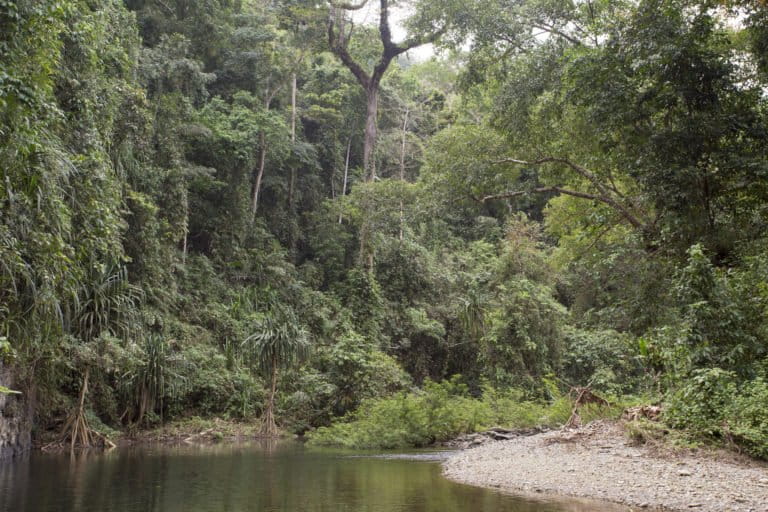- Critical habitats — portions of land outside protected areas that have known habitats of threatened or endemic species — are usually small, focusing on one or a few species.
- The newly declared Cleopatra’s Needle Critical Habitat is the Philippines’ largest, and aims to protect several threatened species.
- The declaration of CNCH involved over three years of negotiations with various stakeholders including Indigenous Peoples communities, government agencies, universities, non-government and private-sector organizations.
In November last year, the Philippines declared its largest critical habitat yet.
Located in the long, narrow Philippine island of Palawan, the new Cleopatra’s Needle Critical Habitat (CNCH) is spread across 41,350 hectares (more than 100,000 acres). The second largest critical habitat, Carmen Critical Habitat for Marine Turtles, spans nearly 6,000 hectares.
Critical habitats — portions of land outside protected areas that have known habitats of threatened or endemic species — are usually small, focusing on one or a few species. For example, the critical habitat declared for the endemic Philippine duck stands at 178 hectares, while that for a critically endangered Rafflesia flower stands at about 16 hectares.
The newly declared Cleopatra’s Needle Critical Habitat is massive in comparison.
“What makes this Declaration so momentous is the size of CNCH is an indication of the sheer number of endemic and/or threatened species which have been identified and recorded across the 41,350 hectares, therefore warranting a Critical Habitat this big,” Karina May REYES-ANTONIO, project coordinator at Centre for Sustainability, told Mongabay.

Palawan, dubbed the last frontier because of the large expanse of old, intact forests it is home to, is one of the most biodiverse regions in the Philippines. The island hosts two World Heritage sites, the Puerto Princesa Subterranean River, and the Tubbataha Reef, and harbors more than a quarter of all animal species found in the country. The island is also home to the last 200 to 300 members of the indigenous Batak tribe.
The CNCH has critical habitat for about 85 percent of the mammals and birds that are found only in Palawan, including the Palawan hornbill, Palawan forest turtle, Palawan bearcat, seven-foot long Palawan monitor lizard, and Palawan pangolin, the critical habitat’s designated mascot, according to a press release.

Besides scientific evidence that the area is critical for one or more species, the declaration of a critical habitat also requires support from all local stakeholders.
The declaration of CNCH, spanned over three years, and involved garnering support from three upland Indigenous Peoples communities, seven lowlander coastal communities, one city government, three national government agencies, six major local and international donors, six local and international universities, one museum, a dozen non-government and private-sector organisations, and a host of local and international researchers, students, and volunteers, REYES-ANTONIO said.
The project was led by the Centre for Sustainability, Palawan Council for Sustainable Development, City Environment and Natural Resources Office of Puerto Princesa and the Batak tribe, with support from Global Wildlife Conservation, Rainforest Trust and the Amphibian Survival Alliance.
“It has been a colossal endeavour to build a strong, productive network between all of these stakeholders based on respect, trust and a mutual determination to understand the priorities of each stakeholder, and level off these expectations for the benefit of all,” REYES-ANTONIO said. “Despite the challenges, it has been a wonderful demonstration of Filipinos coming together to make positive change for our future generations.”
Despite Palawan’s species-rich forests and coastlines, habitat loss due to mining and conversion of forests to agriculture land is driving several species towards extinction. Data from the University of Maryland visualized on Global Forest Watch show that the island of Palawan has lost more than 7 percent of its tree cover between 2001 and 2014. The illegal wildlife trade, too, is a major threat to many of the island species.

Some key bans within the newly declared CNCH, according to the Republic Act (RA) No. 9147, include extraction of minerals, logging, quarrying, killing and collection of wildlife species, and wildlife trading. However, some activities are allowed. For example, established tribal groups and indigenous cultural communities can continue with their practices in accordance with the rules and customs traditionally observed, provided it is for traditional and personal use, and not primarily for commercial purposes, REYES-ANTONIO said.
“There are very few intact places left in the world like Cleopatra’s Needle, which is home to a unique and veritable treasure trove of biodiversity,” Don Church, Global Wildlife Conservation president and director of conservation, said in the statement. “This critical habitat designation is going to help put Palawan on the map as a leader in wildlife conservation and ecotourism, a model we hope inspires the protection of other irreplaceable places throughout the world.”





Citations:
- Greenpeace, University of Maryland, World Resources Institute and Transparent World. “Intact Forest Landscapes. 2000/2013” Accessed through Global Forest Watch on February 01, 2017. www.globalforestwatch.org
- Hansen, M. C., P. V. Potapov, R. Moore, M. Hancher, S. A. Turubanova, A. Tyukavina, D. Thau, S. V. Stehman, S. J. Goetz, T. R. Loveland, A. Kommareddy, A. Egorov, L. Chini, C. O. Justice, and J. R. G. Townshend. 2013. “High-Resolution Global Maps of 21st-Century Forest Cover Change.” Science 342 (15 November): 850–53. Data available on-line from:http://earthenginepartners.appspot.com/science-2013-global-forest. Accessed through Global Forest Watch on February 01, 2017. www.globalforestwatch.org